Yes, the PCIe x16 slot you use DOES matter because, on most motherboards, the second one only offers eight or even just 4 PCIe lanes.
PCIe x16 slots are the most confusing to understand. Knowing which one to use is very important if you are building a PC and have multiple x16 slots on the motherboard.
PCIe lanes, bandwidth, and slot configuration may all sound confusing to you, but they are essential in understanding how your overall system works and how to build a PC properly.
The PCIe x16 slot is the fastest in any generation as it has the most PCIe lanes available, resulting in a higher data throughput (speed in layperson’s terms).
This slot is ideal for large and power-hungry cards like graphics cards.
However, not all x16 slots are created equally.
Some x16 slots have the physical size of an “x16” slot but have fewer lanes. So does it matter which PCIe x16 slot I use? Yes, it does, and in the text below, we will explore why.
TABLE OF CONTENTS
Brief on PCIe Lanes and Slots
PCIe lanes are the highways that connect the PCIe slots to the system for data transfer.
However, the number of PCIe lanes on your system is limited. The CPU and the motherboard chipset determine the total number of PCIe lanes you have.
A typical PC has about 20 PCIe lanes.
All expansion cards have a certain number of PCIe lane requirements. Graphics cards are designed to use 16 PCIe lanes ideally. However, they can operate at a lower lane count but somewhat reduced performance.
NVIDIA Graphics Cards, for example, can work with 16 and 8 PCIe lanes, and AMD Graphics Cards can work with 16, 8, and even four lanes.
Due to the limited nature of PCIe lanes on a PC, you cannot install two graphics cards on two real 16-lane x16 slots, as that would demand a PC with 32 PCIe lanes – commercial PCs do not have so many roads.
Hence, the lane count is divided between the two x16 PCIe slots to operate both cards. More on this is below.
Also Read:
So Does It Matter Which PCIe x16 Slot I Use?
We have already established that it does matter what PCIe x16 slots you use, and here are the reasons why.
x16 Slots vs. TRUE x16 Slots
Unlike the x1, which is straightforward and offers just a single PCIe lane, the same is not valid for an x16 slot!
Sometimes, what may seem like an x16 slot may only have eight or even four lanes.
TRUE PCIe X16 Slot
The True PCIe x16 slots with full 16 lanes are ideal for graphics cards.
As a rule of thumb, the top of the first PCIe x16 slot on a motherboard is a TRUE PCIE x16 slot with 16 lanes.
Hence if you have a single graphics card, ALWAYS use the first PCIe x16 slot!
PCIe x16 Slot with 8 Lanes – x16(x8) Slots
Motherboards designed for NVIDIA SLI or multi-GPU support generally have two PCIe x16 slots.
However, it is worth noting that there is an enormous caveat when using them.
Take the following motherboard, for instance:
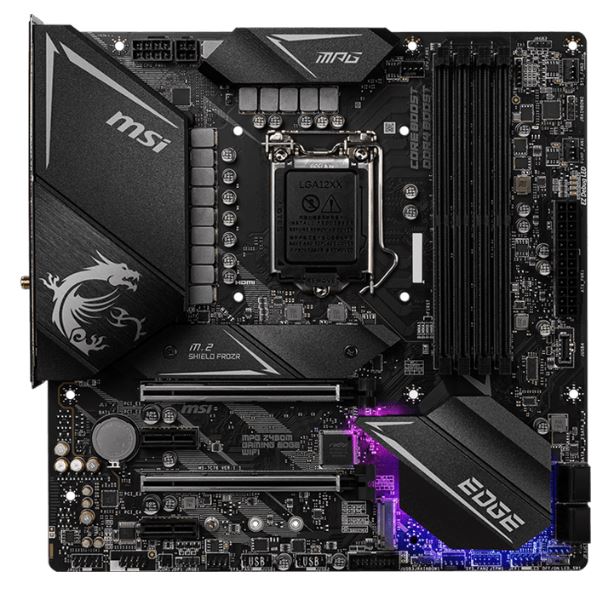
The motherboard above is a typical SLI motherboard, offering 2 x PCIe x16 slots.
However, the lane configuration (or modes) it provides for the two x16 slots are 16/0 and 8/8.
If only the top slot is occupied, it will operate at 16-lane bandwidth.
However, if the bottom slot is populated, the ultimate and second slots will clock to 8 lanes each.
If you do not occupy the top slot and only the bottom x16 slot, it will still operate with 8-lane bandwidth because the bottom slot only has eight hardwired PCIe lanes!
In other words, always use the top PCIe x16 slot if you have a single graphics.
PCIe x16 Slot with 4 Lanes – x16(x4)
Many motherboards offer what visibly may seem like an x16 slot but only has a lane-width of 4 PCIe lanes.
An x16(x4) is VERY common among budget motherboards.
Take, for instance, the following motherboard; it has two PCIe x16 slots. However, counter to your intuition, the second PCIe x16 slot, in fact, only has four lanes.
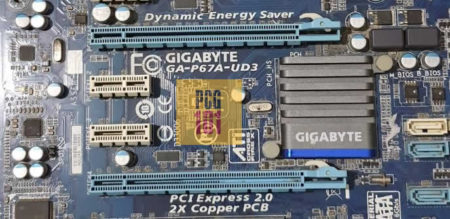
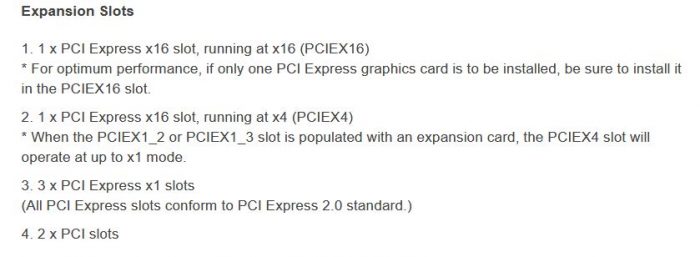
Hence, this would NOT be the ideal slot for graphics cards.
If you want to install a graphics card, you would again use the top one unless you wish to underutilize your graphics card severely.
The bottom x16 slot with four lanes would instead be ideal for smaller cards like SSD expansion cards, video capture cards, risers, etc.
Also Read:
Motherboard with x16 Slots with Different PCIe Version – CPU and Chipset Lanes
It is worth pointing out that the top of the TRUE x16 slot connects to the CPU PCIe lanes, whereas the x16(x4) slot connects to the motherboard chipset PCIe lanes.
This may be essential if your motherboard offers different PCIe versions for the CPU and motherboard chipset lanes.
Take the motherboard with an AMD A320 chipset; for instance, on an A320 motherboard, the CPU lanes conform to version 3.0, whereas the chipset lanes conform to version 2.0 only.
A PCIe version of the interface/slot has enormous ramifications on the performance of the expansion card installed.
For instance, a third-generation PCIe x4 slot can occupy an NVMe SSD with a max read speed of about 3.5 GB/s. The same slot on fourth-generation PCIe can settle an SSD with double the read speed, i.e., 7 GB/s!
Each successive generation doubles the throughput (speed) per PCIe lane compared to the previous generation.
The following table sums this up.
| Version | x1 (GB/s) | x2 (GB/s) | x4 (GB/s) | x8 (GB/s) | x16 (GB/s) |
|---|---|---|---|---|---|
| 1.0 | 0.250 | 0.500 | 1.000 | 2.000 | 4.000 |
| 2.0 | 0.500 | 1.000 | 2.000 | 4.000 | 8.000 |
| 3.0 | 0.985 | 1.969 | 3.938 | 7.877 | 15.754 |
| 4.0 | 1.969 | 3.938 | 7.877 | 15.754 | 31.508 |
| 5.0 | 3.938 | 7.877 | 15.754 | 31.508 | 63.015 |
| 6.0 | 7.877 | 15.754 | 31.508 | 63.015 | 126.031 |
Hence, on certain motherboards, you may find one x16 slot conforming to a newer PCIe generation while the other does to the older one.
Take the following motherboard, for instance,
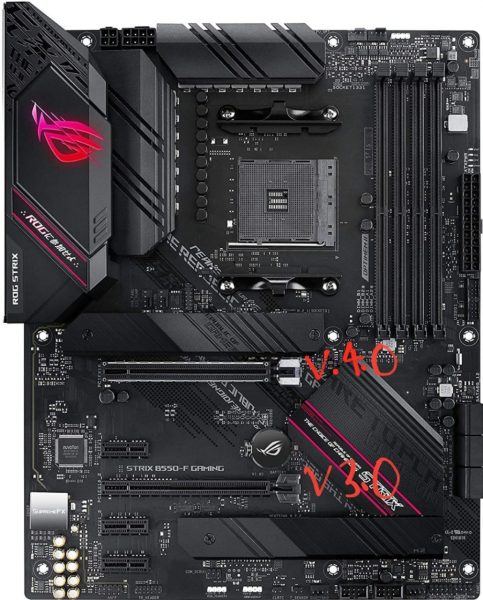
You can learn all this from the motherboard’s specifications, which we highly recommend you check before building your setup.
The following is the specification for this motherboard:
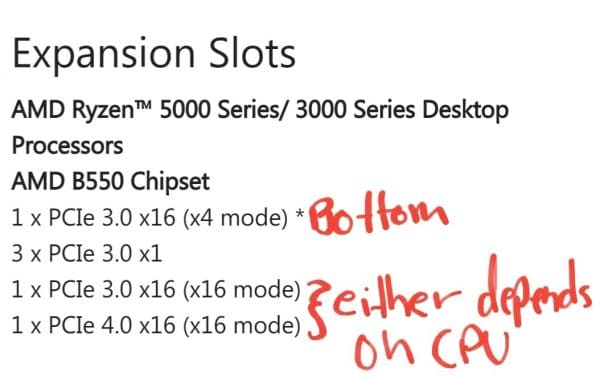
This says the bottom x16 slot operates at x4 bandwidth but will only conform to version 3.0 speeds.
The top PCIe x16 slot has 16 lanes, but it can conform to either PCIe version 3.0 or 4.0, depending on your processor.
In other words, if you have a 3rd or older gen AMD Ryzen processor, the top slot will conform to version 3.0.
If you have a 5th generation AMD Ryzen processor or newer, then the top x16 slot will conform to the more recent version, 4.0.
Hence, it is essential to note that x16 slots on the same motherboard can have different PCIe versions.
The version of the PCIe slot has a lot of impacts, particularly if the card installed has a very high throughput.
PugetSystems has studied the impact of the PCIe version on performance.
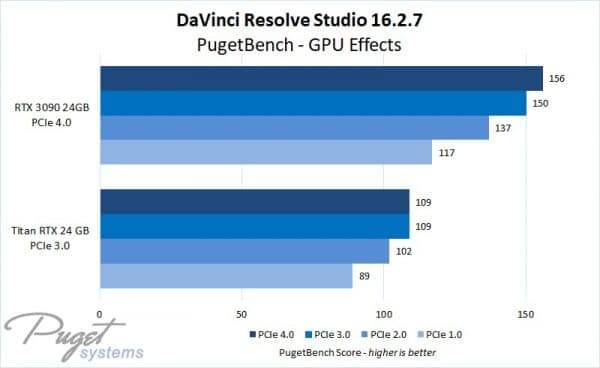
Also Read:
Multiple True x16 Slots – Workstation Grade Systems
Some motherboards have multiple actual x16 PCIe slots.
These motherboards are generally intended for workstation-grade builds.
Recall that a typical budget-oriented commercial PC has 20 PCIe lanes, so having multiple True x16 slots on them is hard.
Workstation builds can easily feature 44 PCIe lanes and multiple True x16 slots.
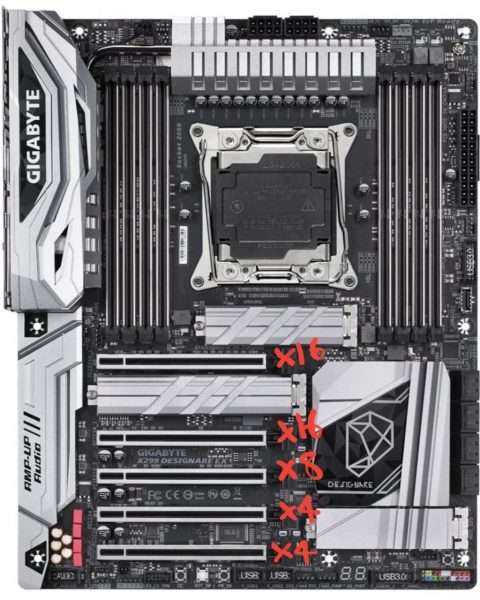
The motherboard has 5 x PCIe x16 slots. The first two are TRUE x16 slots with 16 lanes each. The other three have 8, 4, and 4 routes, respectively.
Any of the True x16 PCIe slots above can be used to work the graphics card to its full potential.
The Impact on the Performance
Using an x16 slot with 8 or 4 PCIe lanes can impact the card’s performance.
For instance, if you install a graphics card in an 8-lane x16 slot, you can expect some marginal performance difference.
GamerNexus Study:
Gamersnexus.net has already done a study on this where they compared the performance difference of GTX 1080 on PCIe 3.0 x16 slot vs. on PCIe 3.0 x8.
The performance difference is marginal but noticeable.
The performance difference will be much more pronounced if you put a high-end graphics card in a four-lane PCIe x16 slot.
PugetSystems GPU Lane Count Performance Study
Another comprehensive study I would like to point to is the one done by PugetSystems.
They had some exciting results whereby they found that having a single graphics card in an x16 or x8 slot does not significantly impact performance.
However, when running two of the same graphics cards together, there was a noticeable difference in performance when using the two in x8/x8 slot compared to the same used in full x16/x16 slots.
In some instances, the difference was as much as 30%!
PugetSystems GPU Lane Version Performance Study
Another critical point to reiterate is that the PCIe version can also significantly impact the performance, mainly if you use a top-of-the-line graphics card that can produce much data.
You can read the complete study here.
Final Words
So, in short, the answer to the question, “does it matter which PCIe x16 slot I use,” is a yes!
If you have two x16 slots and one graphics card, always use the top one for the graphics cards to squeeze the most performance out of it.
It is always recommended that you read the manual/spec sheet of the motherboard to understand how many lanes a PCIe x16 slot offers, what version it conforms to, and whether it is an actual x16 slot or has 8 or 4 PCIe lanes instead.
FREQUENTLY ASKED QUESTIONS
1. Can you use any PCIe X16 slot on your motherboard, or are there specific slots that you should use?
While it may be possible to use any PCIe X16 slot on your motherboard, it is generally recommended that you use specific slots based on your hardware configuration.
For example, if you are using multiple graphics cards in a SLI or CrossFire configuration, you will need to use specific PCIe X16 slots to ensure proper connectivity and performance.
Additionally, some motherboards may have different types of PCIe X16 slots, such as PCIe 2.0 and PCIe 3.0, and you may need to use specific slots based on your hardware requirements.
2. What are some potential issues that can arise if you use the wrong PCIe X16 slot on your motherboard?
Using the wrong PCIe X16 slot on your motherboard can result in a variety of issues, including reduced performance, connectivity issues, and instability or crashes.
If you are using multiple graphics cards, using the wrong slot can also affect the performance of your SLI or CrossFire configuration.
Additionally, using the wrong slot can cause damage to your hardware or other components of your system.
3. Are there any differences between the PCIe X16 slots on your motherboard, such as bandwidth or connectivity options?
Yes, there can be differences between PCIe X16 slots on your motherboard, such as bandwidth and connectivity options. For example, some motherboards may have PCIe 2.0 and PCIe 3.0 slots, which have different bandwidth capabilities.
Additionally, some PCIe X16 slots may have additional connectivity options, such as Thunderbolt or USB, which can affect the compatibility of your hardware.
4. What are some common mistakes to avoid when choosing which PCIe X16 slot to use, and how can you ensure that you are handling hardware safely?
When choosing which PCIe X16 slot to use, it is important to avoid common mistakes such as using the wrong slot for your hardware configuration, using too much force when inserting or removing cards, and not properly grounding yourself before handling hardware.
Additionally, you should avoid working on your computer when it is powered on, and be sure to disconnect all cables and peripherals before working on your system.
To ensure that you are handling hardware safely, it is important to follow best practices and take the necessary precautions.
